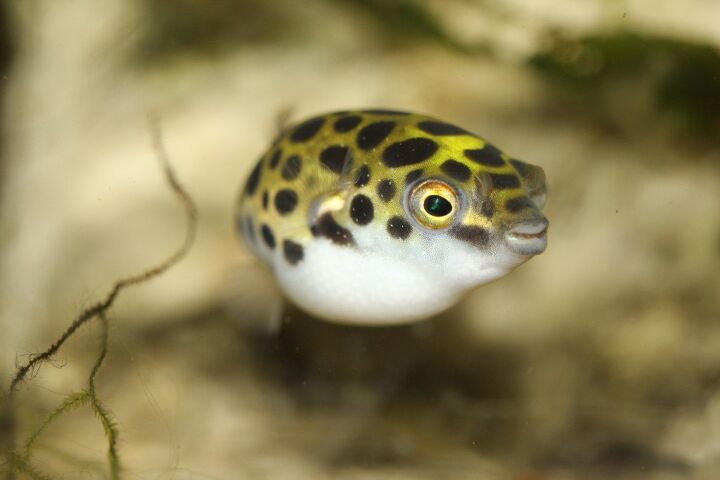Puffer Fish


About Puffer Fish
Puffer fish are a curious species of brackish water fish. They are characterized by their almost box shaped bodies and somewhat comical swimming movements involving their dorsal, anal and caudal fins. Puffers are extremely agile and can swim in almost any direction, but are also extremely slow. Puffers compensates for this with an interesting defense mechanism. When feeling threatened, they will fill their elastic stomachs with water until they are much larger in size and almost round in shape. The puffer fish’s bodies are also covered in tiny, pointed spines, making them a formidable meal when puffed up. Most species of puffers are also poisonous and produce neurotoxins which can sometimes be lethal to predators.
Puffer fishes are a curious species of brackish water fish.
Most puffer fish species originate from tropical Asia in countries like Sri Lanka, Indonesia and Malaysia.
Puffer fish are often brightly colored and come in shades of red, yellow, green, brown and black.
Puffers do best when kept in very large aquariums with plenty of hiding places made of caves, logs and plants. Often, puffer fish will claim a few hiding places as their own. They can also be highly territorial towards each other. For this reason, it is advisable to arrange the puffer fish aquarium in a way that breaks up their line of sight, decreasing the size of the territory each fish will feel it needs to defend.
Puffers are an extremely intelligent species of fish and are known to develop distinct individual personalities. Their personalities and temperament can also change as the fish grow older. Most puffers are predators and therefore should be kept alone or in a species tank. Even the milder species of puffer fish can sometimes nip and harass their tank mates resulting in death from stress. There are also reports of puffers that existed peacefully in a community environment as juveniles suddenly turning aggressive towards their tank mates as they grow older.
Most species of puffer are carnivores and prefer live foods like shrimp and aquarium snails. Puffer can also be trained to accept a variety of frozen foods. An important point to remember though is that puffer fish have extremely strong teeth that grow consistently. So it is important that puffers be provided with shelled foods once in awhile to keep their teeth at a manageable length.
Puffer fish do best when kept in very large aquariums with plenty of hiding places made of caves, logs and plants.
While there are rare reports of puffer fish breeding in the aquarium, it is not a task that can be accomplished with any regularity.
Arrowhead Puffer, King Kong Puffer, Fahaka Puffer, Red Eye Puffer, Target Puffer, etc.
Photo credit: Starseed /Wikimedia

Amy Tokic, Editor of PetGuide.com, is a passionate animal lover and proud pet parent of Oscar, a Shih Tzu/Chihuahua cross, and Zed, a Japanese Chin. Her love of animals began in kindergarten, when she brought her stuffed dog Snoopy into class with her every day. Now, she writes about her adventures in pet ownership and tirelessly researches products, news and health related issues she can share with other animal enthusiasts. In her free time, Amy loves perusing used book and record stores, obsessing over the latest pet products available and chasing squirrels with wild abandon (a habit attributed to spending too much time with her pooches).
More by Amy Tokic
























